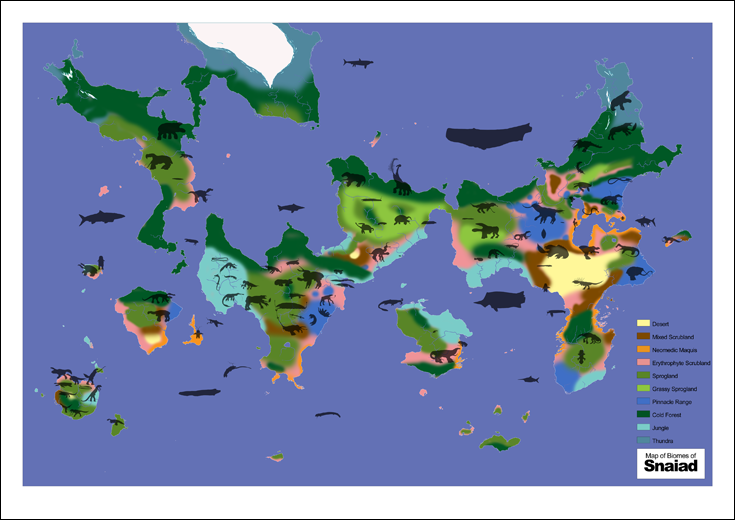Map of Biomes and Habitats
 Click on the map for an enlarged version.
Click on the map for an enlarged version.
This map displays some of the more common habitat types on the planet, as well as the distribution of some of its fauna. Keep in mind that this is an extremely simplified diagram; each "habitat" has numerous variants and sub-biotopes not pictured here, and some of the animals can be found in places they are not pictured. Below is an explanation of the biomes covered by this map.
Deserts are not much different from their equivalents on Earth; dry ecosystems with little plant growth and tremendous day/night temperature variation.
Mixed Scrubland is an extremely variable growth that contains a mixture of Red and Green shrub-like, spiky plants. The "Scrublands" shown here on the map, such as those visible on Thalassia, Aucaterra and Isterna, are completely different from one another.
Neomediterranean Maquis is a unique biotope characterized by water-retaining, heat-resistant plants growing along warm seashores. It is particular to the Neomediterranean region and the Orolandic Aegean.
Erythrophyte Scrubland is a steppe-like growth of Red-plant "grass" equivalents that usually cover seaside plains, but are found inland as well.
Sprogland is characterized by the presence of Sprog; a spongy, hole-ridden, landscape-blanketing vegetative growth that is very common on Snaiad. Sproglands provide succulent food for many herbivores, and also house innumerable small organisms within their depths.
Grassy Sprogland is a biotope unique to the Pansavannah region of Vesterna. Its chief difference from "regular" sprog is the presence of grass-like filamentous plants that carpet the uppermost layer of spongy sprog. Grassy sproglands are enormous reservoirs of plant-held water and nutrients.
Pinnacle Ranges are also unique to Snaiad. They are characterized by open plains dotted regularly by vast, cathedral-like pinnacles; reef-like collections of symbiotic plants. In such an environment, normal plains-type grazers can live alongside island-like concentrations of isolated, jungle-type microhabitats.
Cold Forest is something of a misnomer. Basically, a "cold forest" is any forest that is not a tropical jungle. Tremendously variable, these forests are usually made up from green "trees" that resemble conifers on Earth. In Aucaterra, Thalassia and parts of Notor and Oroland, the chief constituents of "cold forests" are red plants.
Jungles on Snaiad are roughly similar to their Earthly equivalents in that they are home to a mind-numbing diversity of interdependent plants and animals.
Tundras are characterized by the widespread presence of permafrost and ice, dotted by the few hardy red plants that are adapted to the cold.
Copyright laws protect all intellectual property associated with Snaiad.
All artwork, concepts and names associated with this project belong to C. M. Kosemen, unless otherwise stated.